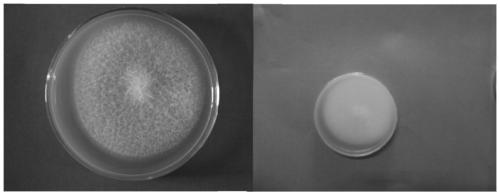A strain of Fusarium solani and its application in Dendrobium candidum against root rot
A technology of Fusarium solani and Dendrobium candidum, applied in the field of microorganisms, can solve the problems of low average yield and slow growth rate of Dendrobium candidum, achieve the effects of improving root rot resistance, good development and application prospects, and improving disease resistance
- Summary
- Abstract
- Description
- Claims
- Application Information
AI Technical Summary
Problems solved by technology
Method used
Image
Examples
Embodiment 1
[0023] A Dendrobium officinale root rot-resistant strain JSNL007-1 was isolated and screened from the plants in the planting area of Dendrobium candidum in Yingtan City, Jiangxi Province. The strain was cultured on a PDA plate, and the hyphae were loose and fluffy; Off-white, milky yellow on the back, such as figure 1 shown.
[0024] The full sequence of the ITS region of the strain JSNL007-1 was amplified and sequenced, and the complete sequence of the rDNA ITS sequence obtained by PCR amplification, as shown in SEQ ID No 1, was found by comparison on the genebank, and the results showed that the strain JSNL007-1 The homology with the Fusarium solani strain (Fusarium solani) is the closest, and the homology with the strains Fusarium solaniQK1409120101 and Fusarium solani CDR3P2F2 both reached 99%. Combined with the morphological and physiological and biochemical characteristics, the strain JSNL007-1 was initially identified as Fusarium solani Bacteria (Fusarium solani), na...
Embodiment 2
[0026] Microbial agents produced by Fusarium solani (Fusarium solani) JSNL007-1:
[0027] (1) Using cottonseed shell fungus residue as the culture substrate, ammonium nitrate as the exogenous nitrogen source, and sucrose as the exogenous carbon source, prepare a solid culture substrate and put it in an autoclave bag, and put it in a high-pressure condition of 121 ° C and 101.3 kPa Sterilize under high temperature for 20 minutes, inoculate the mycorrhizal fungus JSNL007-1 under aseptic conditions after the culture medium is cooled, and then carry out artificial cultivation;
[0028] (2) The specific culture conditions for artificial culture are 20-30 days at 27-30°C, 8 hours of light and 16 hours of darkness per day, and pH6.0.
[0029] (3) Cut the solid microbial bacterial agent cultivated in step (2) into 1cm 3 sized chunks, set aside.
Embodiment 3
[0031] Analysis of the effect of microbial agent produced by Fusarium solani (Fusarium solani) JSNL007-1 on the disease resistance of Dendrobium officinale root rot.
[0032] (1) The solid microbial bacterial agent cultivated in Example 2 is placed on the surface of the cultivation substrate of Dendrobium officinale seedlings, and the inoculation amount of the solid microbial agent of each clump of Dendrobium candidum seedlings is 5-6g. After applying the bacterial agent, the relative water content of the substrate is maintained Above 60% for at least 10 days to ensure that the hyphae survive in the matrix.
[0033] (2) Cultivate the root rot pathogenic bacteria on the PDA medium by ultraviolet light and dark treatment, make the pathogenic spore suspension, it is diluted to 2 * 10 5 a / mL;
[0034] (3) Manage the Dendrobium officinale plants of step (1) under the same conditions, select the fifth leaf on the upper part of the test plants, artificially create wounds with acupun...
PUM
 Login to View More
Login to View More Abstract
Description
Claims
Application Information
 Login to View More
Login to View More - R&D Engineer
- R&D Manager
- IP Professional
- Industry Leading Data Capabilities
- Powerful AI technology
- Patent DNA Extraction
Browse by: Latest US Patents, China's latest patents, Technical Efficacy Thesaurus, Application Domain, Technology Topic, Popular Technical Reports.
© 2024 PatSnap. All rights reserved.Legal|Privacy policy|Modern Slavery Act Transparency Statement|Sitemap|About US| Contact US: help@patsnap.com









